Fallow deer indentation
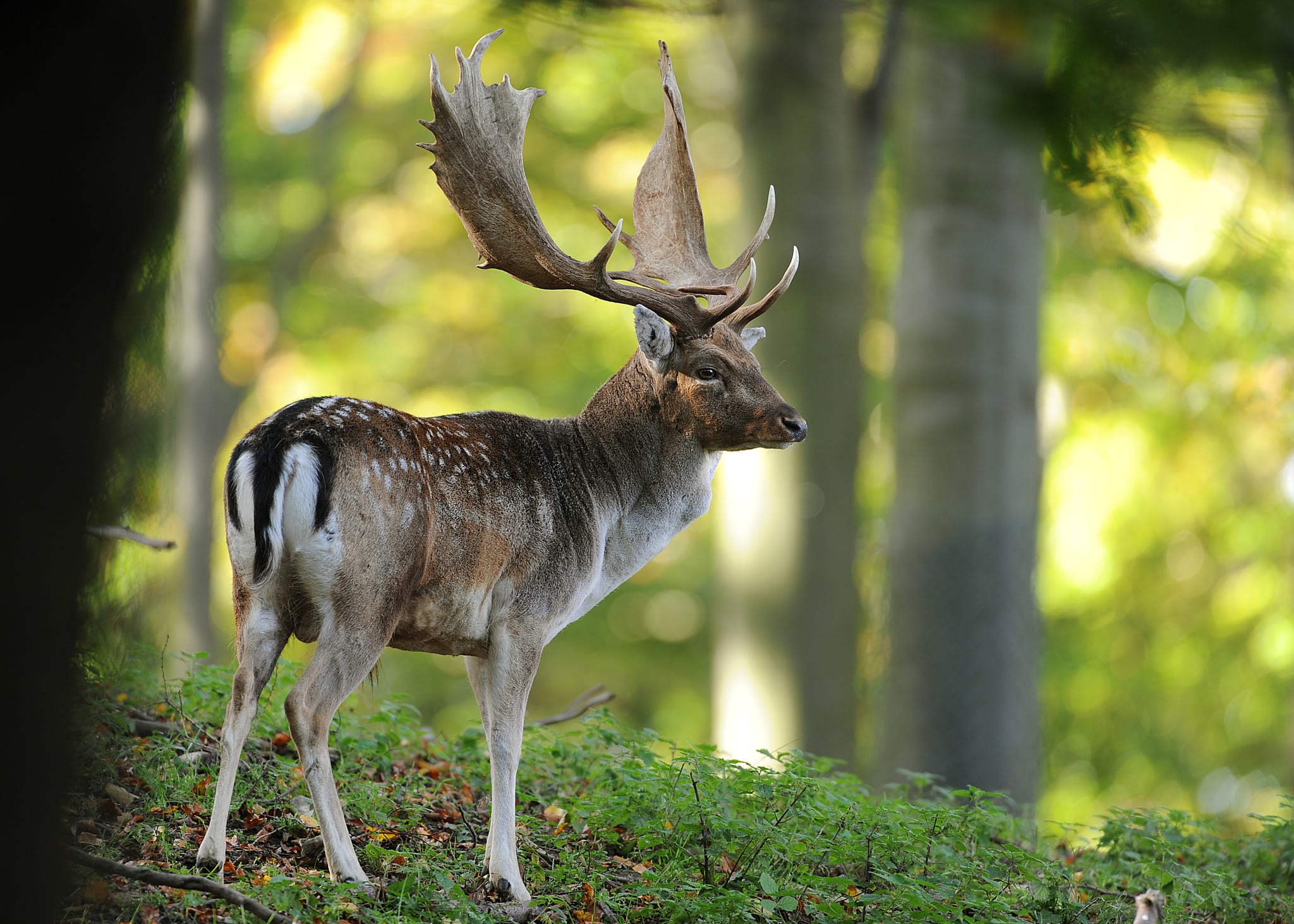
The fallow deer comes from Asia but has been kept in so-called game parks and enclosures in Sweden since the 1500s. Today, the species is found in large parts of Götaland and southernmost Svealand. The distribution is patchy and reflects where releases have taken place. The slow spread is due to the fact that fallow deer do not defend territories and are very faithful to their rutting and calving areas. Despite this, the species is increasing. It is noticeable that the populations are often very dense.
Male fallow deer are called stag or fallow stag. Females that have not had offspring are called “smaldjur” and after that hind, fallow hind or “då”. The offspring is called calf or fallow calf, sometimes stag calf and hind calf.
CHARACTERISTICS
In size, the fallow deer is between red deer and roe deer. Fallow stags develop shovel-shaped antlers, which are carried throughout the entire hunting season. At just over one year of age, the first antlers are rubbed, consisting of points with coronets. The stag is then called a spiker. In the next stage, it is called a palmated stag. He then has a few tines and begins to form his shovel at the top. After that, the shovel increases in size and is first called half-shovel and then full shovel. The stag is usually ten to twelve years old and mature (capital) at that stage. After that, it goes into decline, and the antlers regress. The stag sheds them in April–June.
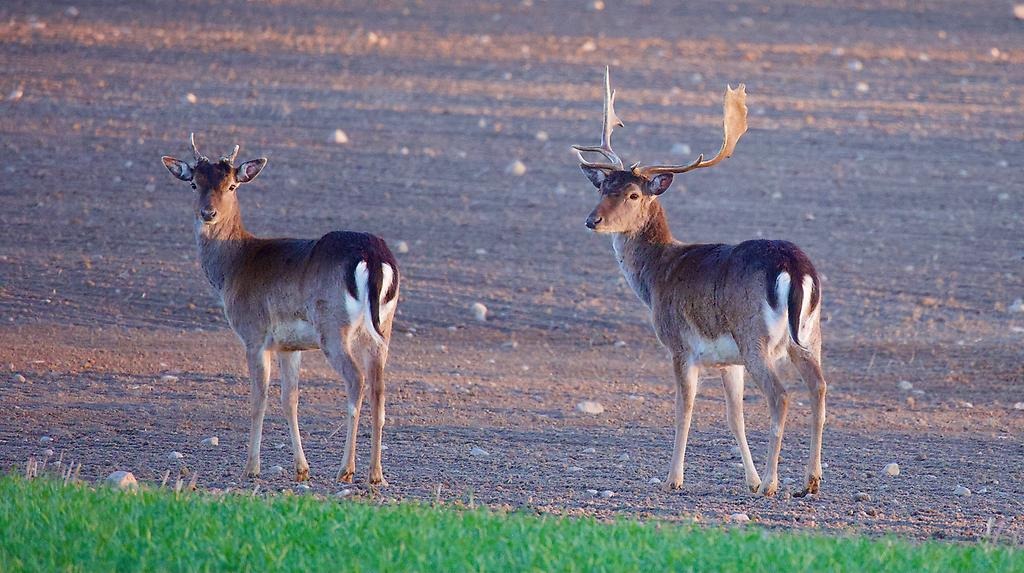
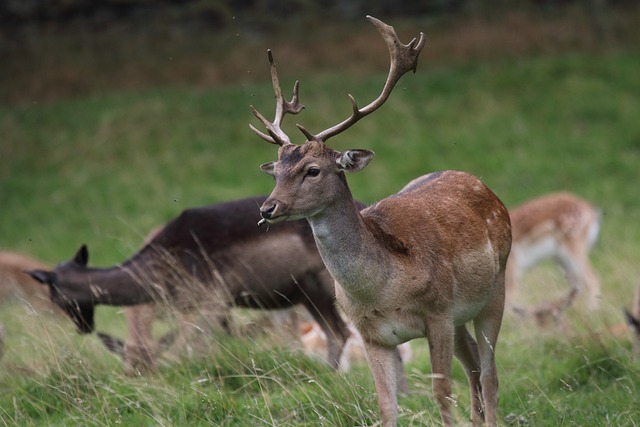
In terms of color, fallow deer are variable. Everything from completely white to black animals occur as a remnant from hundreds of years in captivity. Fallow deer with the original color dominate. In summer, they are reddish-brown with white spots, and in winter more uniformly gray-brown. For the first months, the calf is spotted.
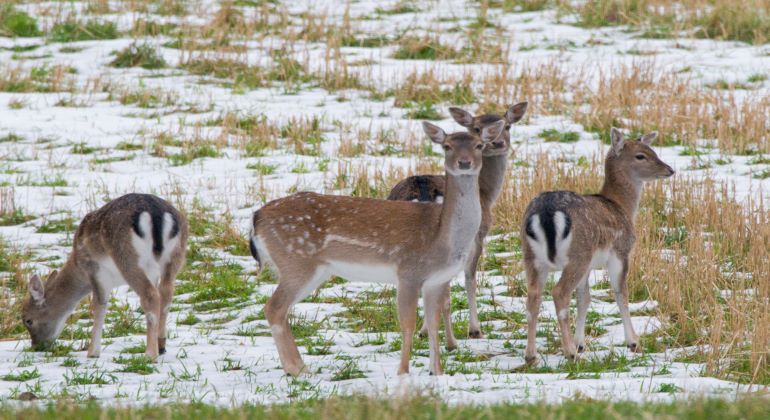
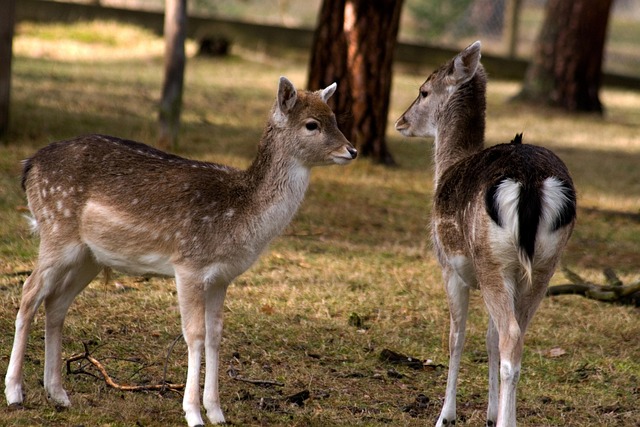
The fallow deer’s rump patch (or “mirror”) is white and bordered by black from the sides and above. Along the up to 20 cm long tail, which is constantly in motion, also runs a black stripe. These three black lines form a black “M” on a white background, which makes it easy to distinguish fallow deer from red deer and roe deer in the field. The species is also recognized by its jerky movements and during flight, bouncing jumps like a hare, which is a warning signal, with the tail held straight up. Compared to red deer, fallow deer is also smaller and differently colored, and has a shorter and blunter snout.
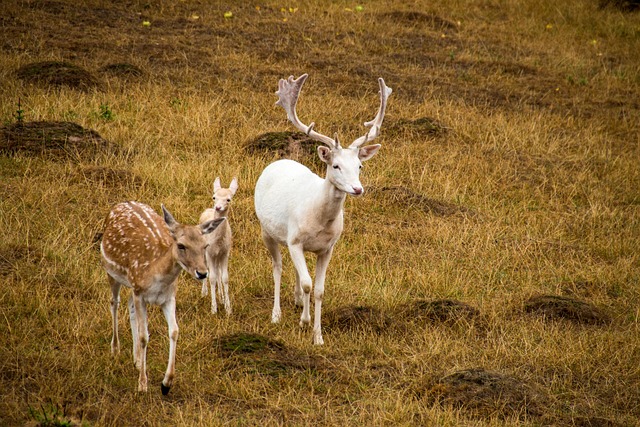
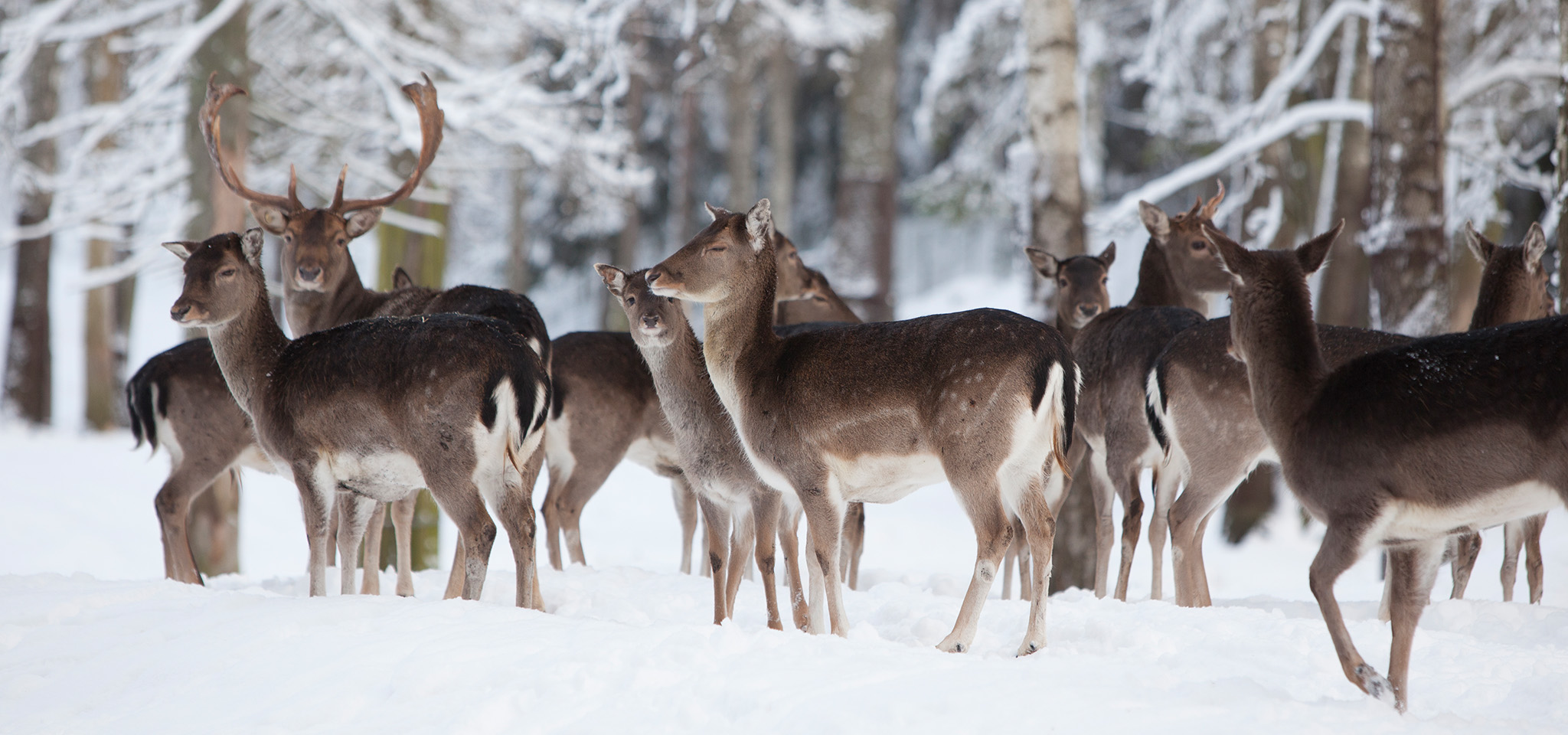
All senses are well-developed in fallow deer. This applies especially to vision, which is better than in both moose and roe deer. The warning call is a short bark. The hind contacts her calf with a mewing sound, and the calf responds with a faint peep.
HABITAT AND HABITS
Fallow deer thrive best in broken landscapes with deciduous or mixed forest with undergrowth and some cultivated land. Their diet is dominated by grasses and herbs, but fallow deer also browse buds and shoots, freshly sprouted leaves in spring, and acorns and beechnuts in autumn and winter. Bark gnawing also occurs, and fallow deer can damage young stands of pine, spruce, and especially deciduous trees. In areas with dense populations, no regeneration of oak, beech or other deciduous trees occurs unless the area is fenced. Fallow deer are also fond of agricultural crops and can cause significant damage in fields of potatoes, sugar beets, peas, oats, wheat and winter rapeseed.
Fallow deer are distinct herd animals and highly site-faithful. Hinds, calves, and smaldjur move together in smaller herds under a lead hind. Spiker stags can also join these. In areas with good forage, many such core herds can temporarily gather into large herds of sometimes several hundred animals. Stags form their own herds. During summer, these “bachelor clubs” can sometimes be found far from their usual home ranges. As autumn and the rut approach, they return home. Fallow deer can press themselves flat, standing still in dense vegetation or lying pressed against the ground like a hare.
A fallow deer population is easy to manage thanks to the animals being site-faithful, living in dense populations, and being easy to feed during harsh winters. Where there are dense fallow deer populations, nutritional competition with other hoofed game can arise.
Compared to our other deer species, fallow deer are much more active during daylight hours. A herd can be seen grazing at any time of day and can stand and graze or lie and ruminate in the open, just as long as they have a good view of their surroundings.
REPRODUCTION
The rut occurs during the second half of October and lasts into November. At that time, the stags gather at rutting areas, where they defend a small territory depending on their strength, which is defended against other stags. The fallow stag’s bellow is not as powerful as the red stag’s, but can be heard up to a kilometer away.
The hinds become sexually mature their second year and give birth in June–July to one single calf, rarely two. Because they only raise one calf and the hind seldom strays far from it, foxes predation on fallow deer calves is much lower than on roe deer fawns.
The late rut and late calving clearly show that the fallow deer is not particularly well adapted to our climate. The species can also encounter problems if the ground is snow-covered for a longer period and, in contrast to red deer, has difficulty adapting to the northern Swedish forest landscape.
TRACK SIGNS AND HUNTING
The fallow deer’s track print is more narrow and pointed than that of the red deer, about eight centimeters long and five centimeters wide, with imprints of the dewclaws behind. The hind’s track is slightly smaller than the stag’s. Other signs include rubbing marks, shed antlers, and rut pits. The size of droppings depends on the animal’s size and are difficult to distinguish from roe deer or red deer droppings.
Hunting of fallow deer can be carried out as both drive hunts and pressure hunts. Fallow deer are also shot using flushing dogs, short-range tracking dogs, or slow-trailing dogs. Additionally, many animals are taken during still hunting and stalking.
Primarily, the culling should consist of calves. If the aim is to reduce the population, more hinds and young females should be culled, but the calf should always be shot before the hind. Often too many adult hinds are shot. This leads to an uneven gender distribution in the population.
Only class 1 rifles and single-barreled shotguns with slug or brenneke rounds may be used. The law requires that a trained dog must be available to track any potentially wounded fallow deer.
DISEASES IN FALLOW DEER
A feared disease is BOVINE TUBERCULOSIS. It was detected during the 1990s in several Swedish fallow deer enclosures but has not been found in other deer species or in wild deer. The disease came to Sweden with the import of deer from England.
Animals become infected with the bacteria via feed or by inhalation. Bovine TB is most often seen as pus-filled abscesses in lymph nodes in the throat, chest, and/or abdominal cavity. In some cases, abscesses are found in other organs.
The disease can affect many animal species and is a feared and difficult-to-treat infection in humans. Transmission can occur when handling infected carcasses and cadavers.
Another common disease is NECROBACILLOSIS, which usually presents as pus-filled abscesses in the mouth and throat. The bacteria occur in soil and dirt. The disease often arises when animals are fed on the ground and the feed is mixed with soil and feces. This is important to consider when feeding wild deer. Infections are most common in enclosures.
Another bacterial disease that affects deer is PSEUDOTUBERCULOSIS. This disease also spreads mainly through poor hygiene at feeding sites.
SUMMARY
- Fallow deer are not naturally found in Sweden. The species was introduced starting as early as the 1500s.
- The spread is slow, which means that fallow deer are still patchily distributed in dense populations around the places where the animals were once released.
- All senses, including vision, are well developed in fallow deer.
- Fallow deer mainly eat grass and herbs, but also browse on buds and shoots from trees and bushes, sometimes even bark. The species can cause damage to agricultural crops.
- Stags form their own groups for most of the year, while does and fawns stay together in herds led by a lead doe.
- Fallow deer are more active during the daytime than other deer species.
- The doe usually gives birth to one, rarely two, fawns.
- The rut occurs in October–November, later than in other deer species. The fawns are also born late, in June–July.
- Fallow deer experience problems and must be supplementary fed if the ground is covered by snow for a longer period.
